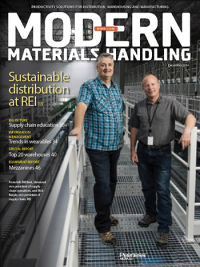Lift Truck Tips: Reducing the capacity for risk
Attachments can impact a forklift’s rated capacity, but by how much? Too many equipment users don’t know the answer.
Latest Material Handling News
60 Seconds with Bob Trebilcock, outgoing executive editor, Modern Materials Handling Learn from lift truck service history Two voices of reason on pallet materials The reBound Podcast: How Pitney-Bowes is innovating with autonomous vehicles. Packaging Corner: Be open to change More BlogsSafety has always been a top priority for employers and employees, but there are only so many ways to mitigate risk, especially in physical, fast-paced and equipment-intensive environments. Solution providers have continued to innovate, aided by smart and connected technologies. However, amid all the high-tech ways to safeguard forklift operators and those around them, a few of the basics are often overlooked.
According to Scott McLeod, president of Fleetman Consulting, an independent forklift fleet management and procurement consulting company, even something as common as forklift attachments can be a source of danger. All safety authority bodies governing the use of forklifts in the workplace require the forklift’s capacity data plate to be accurate and representative of how the forklift is configured, including any applicable attachment. In practice, that is not always the case.
“It’s a big area of neglect, and we’re running into it constantly,” McLeod says. “Some companies properly update capacities, some do it sometimes, and some just plain don’t do it.”
When a piece of equipment is fitted with any attachment other than what it had when it was made, the dealer or installer is obligated to send the engineering data of that attachment to the forklift manufacturer, who in turn is required to send an updated capacity data plate back to the dealer for installation onto the forklift before it is put back into service.
This doesn’t always happen, but McLeod suggests failure to update these plates isn’t always a result of purposeful neglect. “Particularly when a company has a large fleet with their own maintenance staff, they might not know this needs to be done,” he says. “They might bring in a rental, pull the attachment off their own forklift and quickly install it on a rental to keep production moving. Nobody thinks to change the capacity plate.”
Those who willfully sidestep this requirement will likely cite the length of time it takes to get the forklift manufacturer to supply an updated plate, which McLeod says is sometimes a legitimate concern.
“Imagine all North American forklift dealers sending in capacity plate update requests to one person at the factory,” McLeod says. “The response time is typically days or weeks which creates a huge bottleneck in the system. No dealer or end user wants to wait so long, so the updating of capacity plates may be sidestepped to meet production deadlines at the expense of safety, which is unfortunate.”
Any maintenance department trying to keep track of 100+ trucks and the frequent swapping of 30 complicated attachments will be challenged to keep each capacity plate up to date without experiencing significant downtime.
“I don’t see an easy solution,” McLeod admits, “but a starting point is to make sure everyone is aware. I can imagine an integrated system that negates the need for a stamped capacity data plate. Once you hang an attachment on a forklift, maybe a digital readout will tell you the capacity at whatever load center you like. This could leapfrog the problem of producing plates quicker.”

Article Topics
Blogs News & Resources
60 Seconds with Bob Trebilcock, outgoing executive editor, Modern Materials Handling Learn from lift truck service history Two voices of reason on pallet materials The reBound Podcast: How Pitney-Bowes is innovating with autonomous vehicles. Packaging Corner: Be open to change 60 Seconds with Robert Martichenko of American Logistics Aid Network The reBound Podcast: Looking for talent in all the right places: How Essendant is revolutionizing recruitment More BlogsLatest in Materials Handling
Registration open for Pack Expo International 2024 Walmart chooses Swisslog AS/RS and software for third milk processing facility NetLogistik partners with Vuzix subsidiary Moviynt to offer mobility solutions for warehouses Materials Handling Robotics: The new world of heterogeneous robotic integration Lucas Watson appointed CSO for Körber’s Parcel Logistics business in North America Hyster recognizes Dealers of Distinction for 2023 Carolina Handling names Joe Perkins as COO More Materials HandlingAbout the Author
Subscribe to Materials Handling Magazine

Find out what the world's most innovative companies are doing to improve productivity in their plants and distribution centers.
Start your FREE subscription today.
April 2024 Modern Materials Handling

Latest Resources











